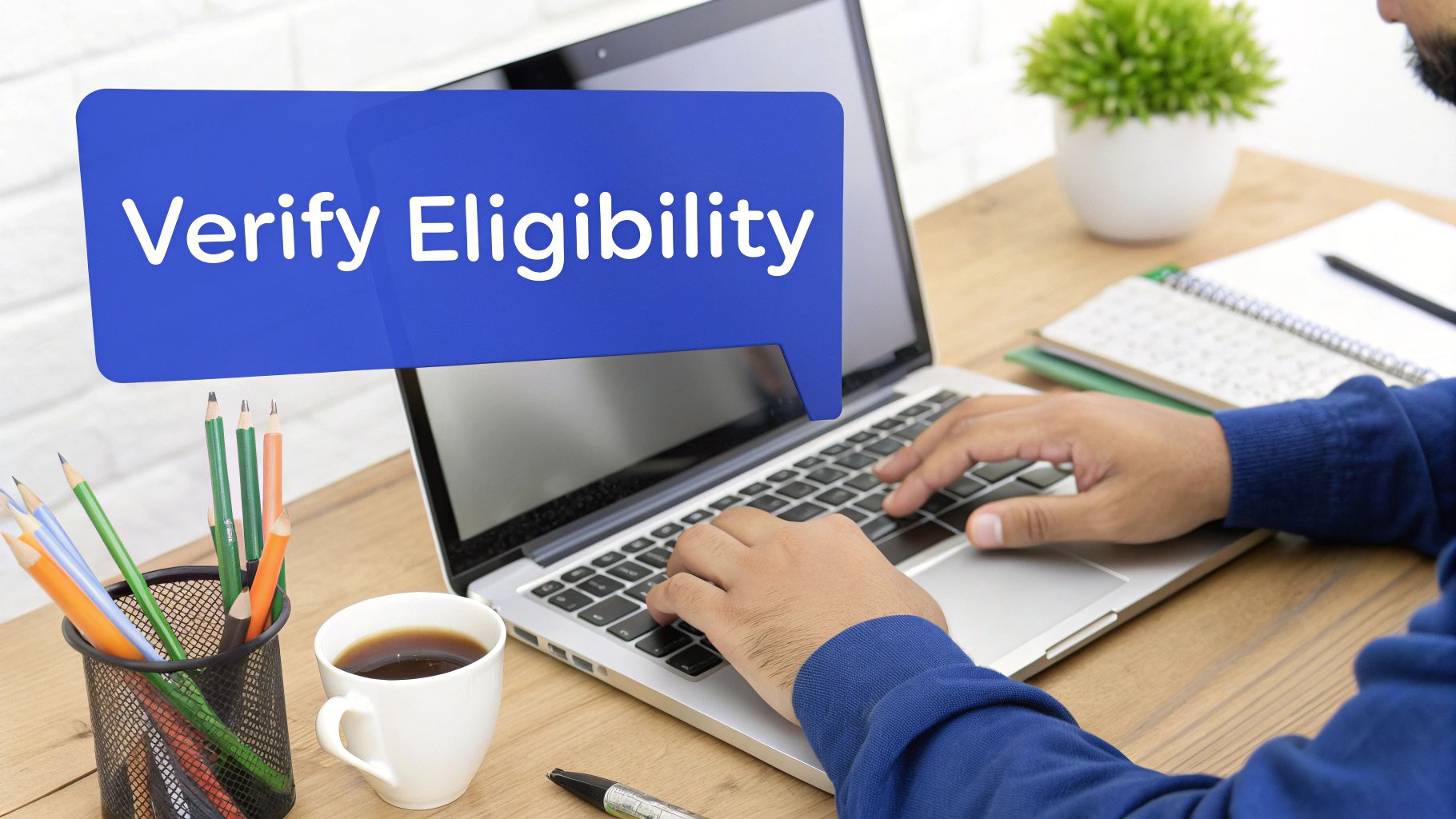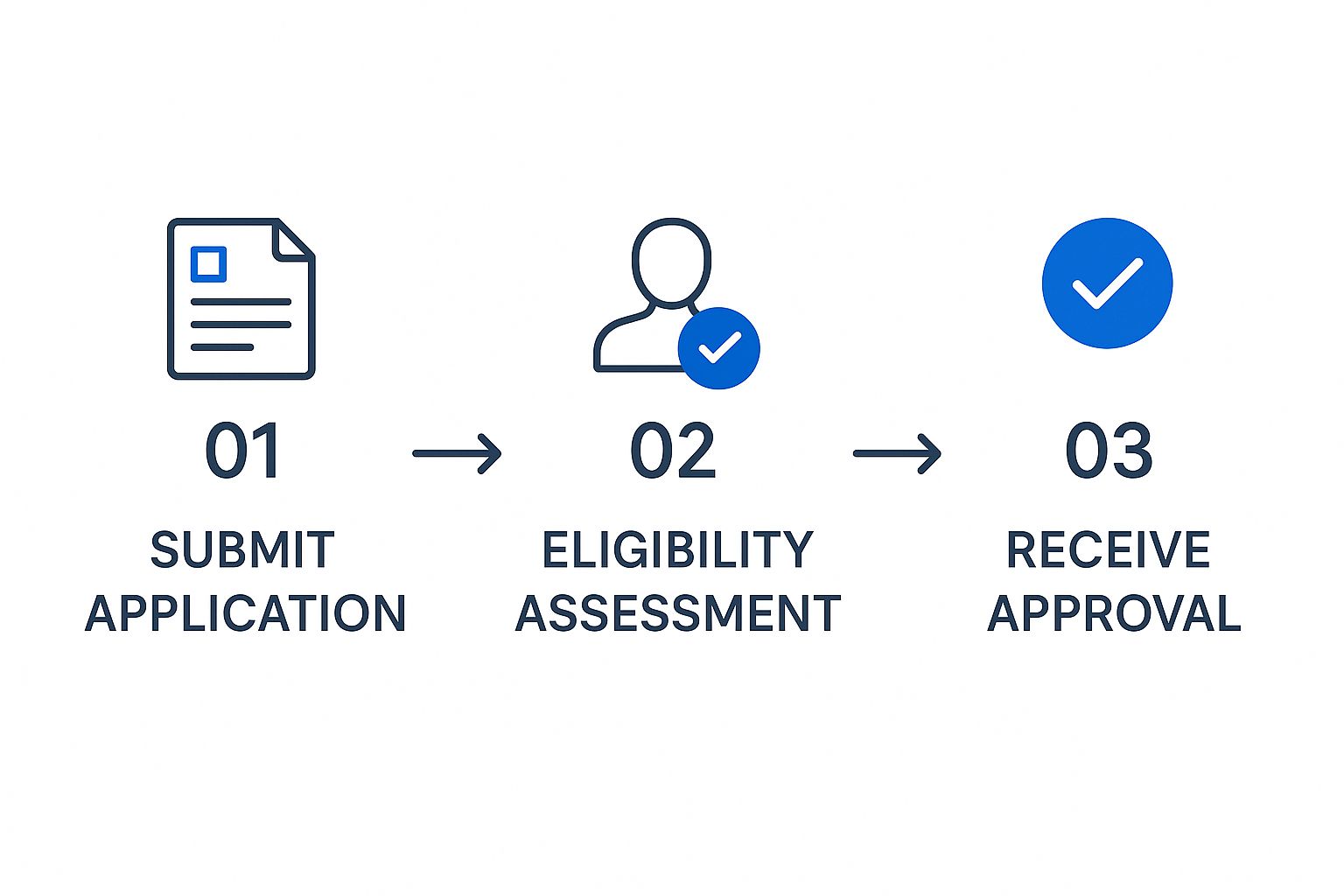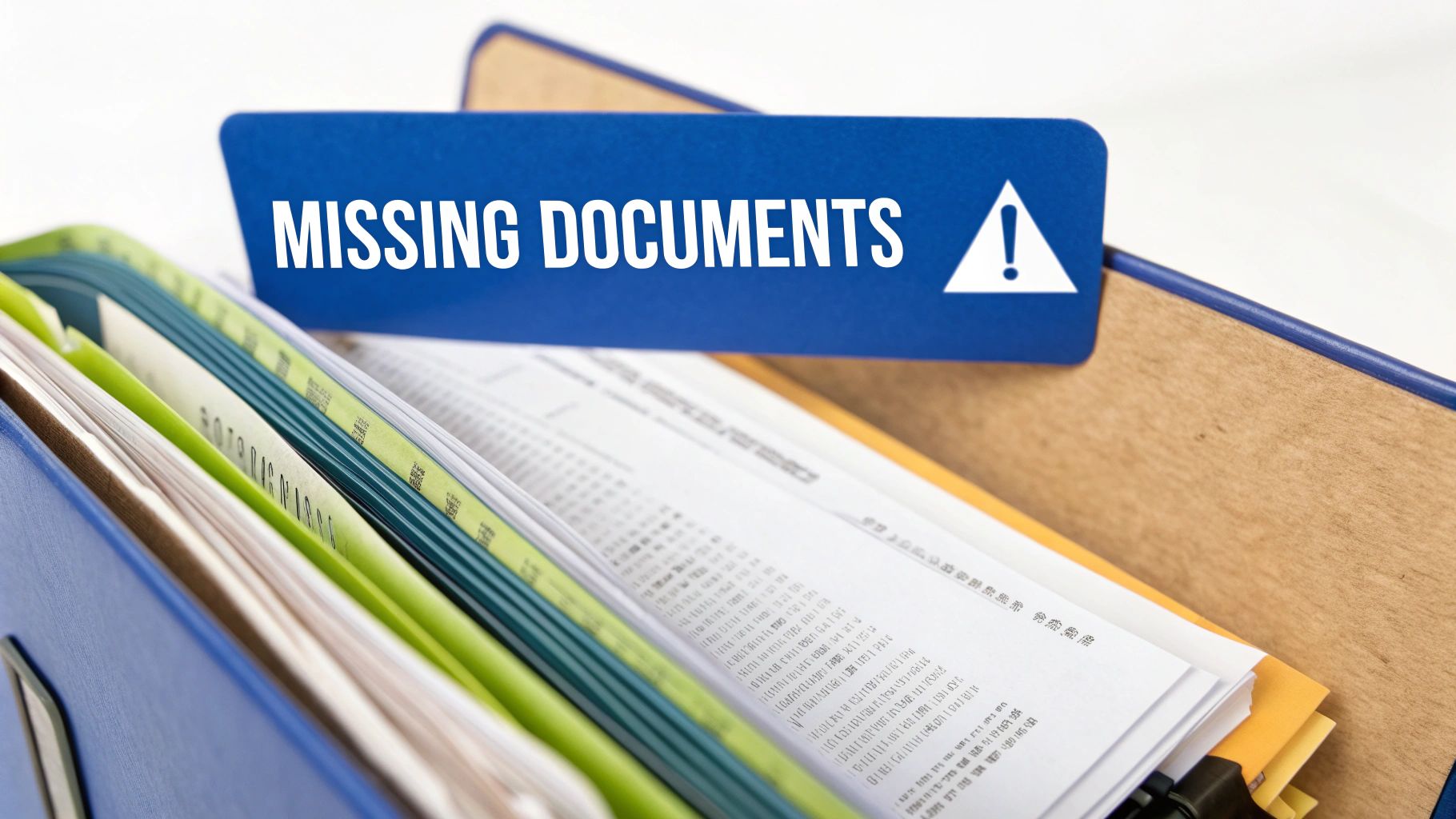Understanding Medicaid Coverage Verification Basics

Medicaid coverage verification is a critical part of healthcare administration. While it can seem complicated, understanding the basics can make the process much smoother. This section will walk you through the essentials, explaining key terms and the core verification steps. This knowledge is vital for healthcare professionals, impacting daily tasks and patient care.
Why Verify Medicaid Coverage?
Verifying Medicaid coverage is crucial for several important reasons. It helps ensure patients receive the care they need without facing unexpected costs. This offers peace of mind for both patients and providers. Accurate verification also protects healthcare practices from rejected claims and lost revenue, enabling better financial planning and resource management.
The Scope of Medicaid
The sheer size of the Medicaid program highlights the need for effective verification. As of December 2024, Medicaid and CHIP covered 78,532,341 people across the U.S. and the District of Columbia. That's about 20% of the entire U.S. population. Managing coverage for this many people requires strong data systems and careful adherence to rules. For a deeper dive into the numbers, check out the Medicaid and CHIP Enrollment Data.
Key Components of Verification
The verification process has a few main parts. First, you'll need to gather patient information, like their name, birthdate, and Medicaid ID number. Next, you'll need to use verification systems, which might include online portals or contacting Medicaid directly. Finally, correctly interpreting the results is essential for figuring out eligibility and coverage specifics. Each step in this process requires attention to detail.
Understanding Eligibility and Benefits
Medicaid eligibility determines whether a patient qualifies for Medicaid based on factors like income and household size. Benefits describe the services covered by a patient's specific Medicaid plan. These can differ from state to state and even between plans within a state. Understanding both eligibility and benefits is key for accurate billing and making sure patients get the care they're entitled to. The following sections will provide more detail on how to perform Medicaid coverage verification.
Your Step-By-Step Medicaid Coverage Verification Process
Medicaid coverage verification is crucial for both patients and healthcare providers. It ensures patients access necessary care and providers receive correct reimbursement. While the process is vital, it can be complicated. This guide breaks down the key steps, making Medicaid verification easier to navigate.
Gathering Patient Information
The first step involves collecting accurate patient details. This includes the patient's full name, date of birth, Medicaid ID number, and the coverage's effective date. Accurate information is essential to avoid delays or inaccuracies. Confirming details directly with the patient can prevent these problems. If a patient has other insurance, gather that information, too, for coordinating benefits.
Accessing Verification Systems
With accurate patient information, you can access the right verification systems. Several methods exist, including online portals, dedicated phone lines, and third-party verification tools like Availity. The best method depends on your state's Medicaid program and your practice's resources. Some states have real-time online portals for instant verification. Others require phone calls or faxes. Understanding your local options improves efficiency. You might find this helpful: How to master the Medicaid application process.
Interpreting Verification Results
The verification system provides results regarding the patient’s Medicaid eligibility and coverage details. Accurate interpretation is crucial for correct billing and patient care. Results typically show whether the patient is actively enrolled, their coverage type, and any benefit limitations or restrictions. Understanding these details is vital for determining covered services and billing correctly. This may also include understanding co-pays, deductibles, or cost-sharing associated with the patient’s plan.

The infographic above simplifies the Medicaid application and enrollment process. It shows the steps from application submission to eligibility assessment and final approval. This simplified view highlights the sequential steps and the goal of obtaining coverage. However, real-world verification often involves more complex details.
Documentation and HIPAA Compliance
Maintaining proper documentation throughout the verification process is crucial. This includes recording the date and time of verification, the method used, the results, and any actions taken. Thorough documentation protects your practice during audits or disputes and supports accurate record-keeping. All verification must follow HIPAA regulations to ensure patient information privacy and security. This involves using secure systems, protecting patient data, and following strict confidentiality rules. This combination of documentation and HIPAA compliance builds trust with patients and facilitates a smooth process.
Essential Tools That Actually Work For Verification

Once you’ve mastered the steps in the Medicaid coverage verification process, it’s time to pick tools that keep things moving smoothly. The right solution can cut down paperwork, reduce errors, and speed up eligibility checks. In this section, we’ll walk through state-run portals and third-party platforms so you can find the option that fits your workflow.
Government Portals And Systems
Many states maintain their own verification sites, often hosted through Medicaid.gov. These portals offer:
- Real-time Verification for instant eligibility checks
- Direct access to official eligibility records
- No fees for basic verifications
That said, each state’s interface and requirements differ, which means you’ll need to learn how each portal works and adapt to changing layouts or login procedures.
Third-Party Verification Platforms
If you handle large volumes or need deeper reporting, a third-party platform may be the answer. Look for solutions that provide:
- Batch Processing to submit multiple checks at once
- Integration Options with electronic health records (EHR) or practice management systems
- Detailed dashboards and analytics
While these tools often carry subscription or per-transaction fees, they can save time by cutting manual data entry and minimizing mistakes.
Key Features To Consider
Before choosing a tool, size up these critical factors:
- Real-time Verification: Ensures you see eligibility results immediately
- Integration Options: Connects smoothly to your existing systems
- Cost Structure: Free access vs. per-verification or subscription fees
- Best Fit For: Identify who will use the tool—front desk, billing team, or clinical staff
Comparing Your Options
Below is a snapshot of common Medicaid verification solutions. Use it to weigh pros and cons and pinpoint which type of platform meets your needs.
Introduction: This table compares features, costs, and capabilities of different Medicaid verification platforms and systems.
Medicaid Verification Tools Comparison
Compare features, costs, and capabilities of different medicaid verification platforms and systems
| Platform Type | Real-time Verification | Integration Options | Cost Structure | Best For |
|---|---|---|---|---|
| Government Portals | Often Available | Limited | Usually Free | Basic Verification Needs |
| Third-Party Platforms | Typically Available | Extensive | Varies (Per Verification or Subscription) | High-Volume Verification, Advanced Reporting |
After reviewing this comparison, you can see that government portals suit practices with lower verification volumes, while third-party systems excel for organizations needing batch processing and deeper insights.
Choosing The Right Tool For Your Needs
A small clinic with occasional Medicaid checks might stick with a free state portal. Larger practices processing many verifications will likely benefit from a paid platform offering automation and analytics. Assess your current workload, budget, and technical capabilities to select the tool that will boost accuracy, save time, and improve overall patient experience.
Solving Common Verification Roadblocks
Medicaid coverage verification is crucial, but it can be tricky. Even experienced professionals run into obstacles. This section tackles common challenges and provides practical solutions for real-world scenarios. We'll explore ways to overcome incomplete patient information, system failures, and data discrepancies.
Handling Incomplete Patient Information
Getting complete patient information can sometimes be a struggle. Incomplete information, however, can stall the entire verification process. Instead of putting patients on the spot, try these strategies:
- Utilize online patient portals: Patient portals offer a convenient way for patients to update their information directly.
- Collaborate with other departments: Your front desk or intake staff may already have some of the missing details.
- Access previous records: If the patient has visited before, their existing file might contain the needed information.
This multi-pronged approach minimizes the burden on the patient while increasing your chances of gathering the necessary data.
Dealing With System Crashes and Errors
System crashes can bring your workflow to a standstill. When systems fail, it's essential to have backup plans in place:
- Maintain offline records: Keep physical or electronically stored backups of key patient information.
- Establish alternative communication channels: Have a phone or fax number available as a fallback if online systems are unavailable.
- Familiarize yourself with system recovery procedures: Knowing the recovery process minimizes downtime when the system goes down.
These proactive steps can help you quickly recover and continue with verification, even with technology hiccups.
Resolving Data Discrepancies
Sometimes, information from different sources conflicts. This causes confusion and processing delays. Here's how to handle discrepancies:
- Verify information with the patient: Confirming directly with the patient often resolves minor inaccuracies.
- Contact the Medicaid agency directly: For complicated discrepancies, contacting Medicaid directly offers the most reliable solution.
- Document all discrepancies and actions taken: A record of the issue, the steps you took, and the resolution protects your practice and ensures accurate record-keeping.
Addressing discrepancies promptly and methodically leads to accurate verification.
Managing Pending Eligibility and Retroactive Adjustments
Pending eligibility and retroactive coverage adjustments present unique challenges. For pending cases:
- Follow up regularly: Consistent follow-up with the Medicaid agency keeps the process moving forward.
- Communicate clearly with the patient: Keep the patient informed about their eligibility status.
For retroactive adjustments:
- Review affected claims: Identify which claims need adjustments based on the retroactive coverage.
- Update billing records: Ensure your system reflects the accurate coverage and payment information.
These steps enable your practice to adapt to coverage changes and maintain accurate financial records.
Coordinating Benefits for Patients With Multiple Insurances
When patients have multiple insurance plans, coordination of benefits is essential. Determine which payer is primary and which is secondary. This impacts claim processing and prevents overpayments. Contacting each insurance provider directly clarifies the coordination of benefits rules.
Proactive Strategies and Troubleshooting Techniques
Preventing problems is always better than solving them. Smart practices use preventive measures to avoid common verification errors. Implementing quality control checks, such as double-checking patient information and verification results, improves accuracy. Regular staff training on verification procedures and regulatory updates ensures consistency.
When problems arise, troubleshooting techniques help you solve them efficiently. Create a troubleshooting guide for common verification roadblocks. This guide should outline steps for resolving issues like system errors, missing information, and discrepancies. For more information on financial aid for senior care, see our page on senior care financial assistance. Combining preventive measures and effective troubleshooting significantly reduces verification errors and improves overall efficiency. This ensures a smoother process for both your practice and your patients.
How Medicaid Expansion Changed Everything

The Affordable Care Act (ACA) significantly impacted Medicaid, expanding eligibility and creating ripple effects across the healthcare system. This expansion didn't just increase enrollment; it fundamentally changed how Medicaid coverage verification works for healthcare providers. Understanding these shifts is crucial for navigating today's complex eligibility requirements.
The Impact on Verification Systems
The surge in Medicaid enrollment strained existing verification systems. Many states saw significant increases in applications and requests for verification. This led to longer processing times and increased administrative burdens on healthcare practices.
Additionally, more frequent eligibility changes, due to fluctuating incomes and other factors, required more frequent verifications. This added complexity required new strategies and tools to manage the increased demand.
Technological Advancements
To address these challenges, new technologies emerged. Real-time verification systems became more common, allowing quicker access to eligibility information. Batch processing tools enabled practices to verify multiple patients simultaneously. These advancements helped make the process more efficient, although challenges remain.
More detailed statistics can be found here: Medicaid State Fact Sheets. Following the ACA's implementation, Medicaid enrollment increased substantially. By 2023, about 18.9% of Americans relied on Medicaid. As of 2024, Medicaid provides coverage to approximately 83 million low-income individuals.
Shifts in Patient Demographics and Coverage
Medicaid expansion broadened the program's reach, shifting patient demographics and coverage types. More working-age adults gained coverage, changing the mix of beneficiaries. This shift required healthcare providers to adapt their verification strategies to the diverse needs of a broader patient population.
For instance, some states introduced new coverage options and benefit packages, further adding to the complexity of verification. This changing landscape emphasizes the need for ongoing training and adaptable verification processes. You can learn more here: In-Home Care & Medicaid.
Understanding these demographic and coverage shifts is key for ensuring accurate and timely verification. This helps providers offer the best possible care while managing their administrative responsibilities effectively.
Best Practices For Consistently Accurate Results
Want to achieve verification accuracy that makes your colleagues envious? These best practices, drawn from leading healthcare organizations, will help you master reliable Medicaid coverage verification. We'll cover quality assurance techniques, effective staff training, and workflow optimization for both accuracy and efficiency.
Establishing Strong Verification Policies
A solid foundation starts with well-defined verification policies. These policies should include detailed procedures for common issues like disputed eligibility and navigating appeals. This protects both your organization and patients. For example, a clear chain of command for escalating complex cases ensures timely resolution. Regular audits of verification procedures will identify and address any gaps.
Training and Education for Your Team
Even with the best systems, well-trained staff are essential. Regular training keeps your team up-to-date on Medicaid verification procedures, policy changes, and system updates, reducing errors from the outset. Practical exercises and case studies can reinforce learning and build real-world skills.
Streamlining Your Verification Workflow
Workflow optimization drastically improves accuracy and efficiency. Automating verification requests and follow-ups ensures nothing is missed. This could involve integrating your verification system with your Electronic Health Record (EHR) or practice management software. For related information, you might find this article helpful: How to master financial aid for senior care.
Data Integrity and Follow-Up Procedures
Accurate patient data is crucial. Regular data integrity checks ensure your patient database is current. Automated reminders for patients to update their contact and insurance information can be beneficial. Establish follow-up procedures for pending verifications to prevent delays, perhaps using automated alerts for staff.
Staying Compliant With Changing Regulations
Medicaid regulations are constantly changing. Assign a team member to monitor updates and revise verification procedures accordingly. This proactive approach avoids compliance issues and ensures accuracy. Staying informed about Electronic Visit Verification (EVV) updates for home health and direct billing is also important.
Measuring and Improving Accuracy
Tracking key metrics helps pinpoint areas for improvement. Monitor your verification accuracy rate, the percentage of successful verifications compared to total attempts. This reveals insights into your team's performance and highlights areas for refinement. Below is a table summarizing key metrics for measuring verification accuracy:
The following table outlines key performance indicators and benchmarks for measuring Medicaid verification success:
Verification Accuracy Metrics
| Metric | Industry Standard | Best Practice Target | Measurement Method | Improvement Actions |
|---|---|---|---|---|
| Verification Accuracy Rate | 90% | 95% or higher | (Successful Verifications / Total Attempts) * 100 | Targeted training, workflow optimization, system upgrades |
| Average Processing Time | 2 business days | 1 business day | Track time from request to completion | Automation, streamlined processes, dedicated staff |
This table clearly shows that while a 90% verification accuracy rate is standard, best practice aims for 95% or higher. Reducing processing time from two business days to one is also a key target.
Structuring for Speed and Precision
High-performing practices prioritize both speed and precision. Consider dedicated roles for specific parts of the verification workflow. One team member might gather patient information, while another handles system interactions and interprets results. This specialization boosts efficiency and expertise.
By following these best practices, you can build a reliable verification process that minimizes errors, increases efficiency, and benefits both your practice and your patients. This proactive, detail-oriented approach creates a sustainable system for managing the evolving demands of Medicaid coverage verification.
What's Coming Next In Medicaid Verification
Medicaid coverage verification is constantly changing. Staying up-to-date on these changes can significantly benefit your practice. This section explores the innovations and policy shifts shaping the future of verification. By understanding these trends, you can prepare your organization and build a more efficient system.
The Rise of Automation and AI
Automated systems are taking over routine verification tasks. This allows staff to concentrate on complex cases and boosts overall efficiency. Artificial intelligence (AI) is also playing a larger role, with algorithms designed to interpret healthcare data. This can result in more accurate and faster verification.
Blockchain's Potential for Data Security
Blockchain technology has the potential to transform healthcare data security. By creating secure and transparent patient information records, blockchain could simplify verification and minimize fraud. While still early in development, blockchain’s application in Medicaid verification is very promising.
Evolving Regulations and Policy Initiatives
Regulatory changes and policy initiatives are constantly reshaping verification requirements. Staying informed about these updates is essential for compliance. For instance, updates to Electronic Visit Verification (EVV) requirements for home health services impact how providers document and verify care. This requires practices to adapt their systems.
Recent updates have changed EVV requirements for both Standard Plans and Tailored Plans, changing how providers capture visit data. These changes highlight the constant need for adaptation in verification processes.
The Patient Experience and Expectations
Patient expectations are changing, driving new approaches to verification. Patients desire a streamlined and efficient process. This means healthcare providers must adopt methods that reduce wait times and clearly communicate coverage information. This patient-centered approach boosts satisfaction and builds trust.
Preparing for the Future of Verification
Adapting to these changes requires proactive planning. Investing in staff training on new technologies and procedures will ensure your team is prepared. Regularly reviewing and updating your verification policies will help maintain compliance with changing regulations. Creating a flexible verification system will allow you to quickly adapt to future changes.
Looking for reliable and compassionate in-home care? Caring Hands Senior Services offers personalized care for seniors and individuals with disabilities in Princeton, NJ, and surrounding Mercer County. Contact us today to learn more.

